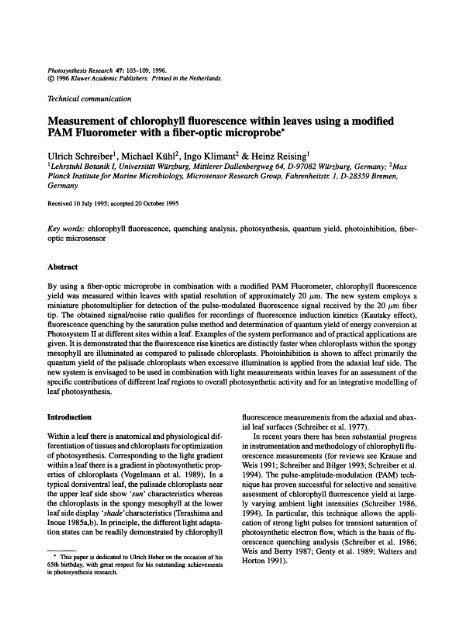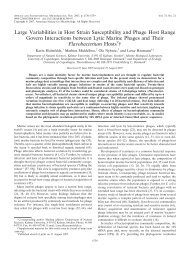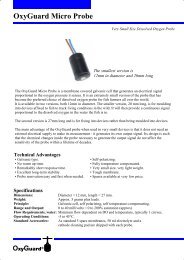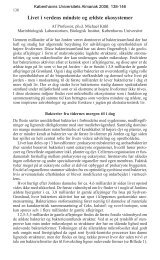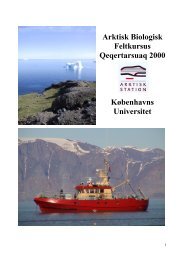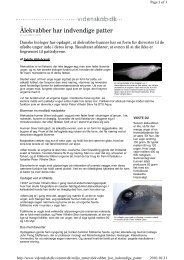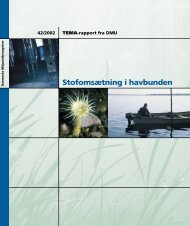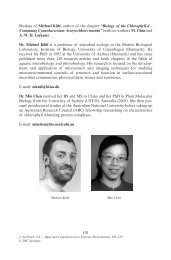Measurement of chlorophyll fluorescence within leaves ... - Springer
Measurement of chlorophyll fluorescence within leaves ... - Springer
Measurement of chlorophyll fluorescence within leaves ... - Springer
You also want an ePaper? Increase the reach of your titles
YUMPU automatically turns print PDFs into web optimized ePapers that Google loves.
Photosynthesis Research 47: 103-109, 1996.<br />
~) 1996 Kluwer Academic Publishers. Printed in the Netherlands.<br />
Technical communication<br />
<strong>Measurement</strong> <strong>of</strong> <strong>chlorophyll</strong> <strong>fluorescence</strong> <strong>within</strong> <strong>leaves</strong> using a modified<br />
PAM Fluorometer with a fiber-optic microprobe*<br />
Ulrich Schreiber 1, Michael Kiahl 2, Ingo Klimant 2 & Heinz Reising 1<br />
I Lehrstuhl Botanik I, Universitat Wiirzburg, Mittlerer Dallenbergweg 64, D-97082 Wiirzburg, Germany; 2Max<br />
Planck Institute for Marine Microbiology, Microsensor Research Group, Fahrenheitstr. 1, D-28359 Bremen,<br />
Germany<br />
Received 10 July 1995; accepted 20 October 1995<br />
Key words: <strong>chlorophyll</strong> <strong>fluorescence</strong>, quenching analysis, photosynthesis, quantum yield, photoinhibition, fiberoptic<br />
microsensor<br />
Abstract<br />
By using a fiber-optic microprobe in combination with a modified PAM Fluorometer, <strong>chlorophyll</strong> <strong>fluorescence</strong><br />
yield was measured <strong>within</strong> <strong>leaves</strong> with spatial resolution <strong>of</strong> approximately 20 #m. The new system employs a<br />
miniature photomultiplier for detection <strong>of</strong> the pulse-modulated <strong>fluorescence</strong> signal received by the 20 #m fiber<br />
tip. The obtained signal/noise ratio qualifies for recordings <strong>of</strong> <strong>fluorescence</strong> induction kinetics (Kautsky effect),<br />
<strong>fluorescence</strong> quenching by the saturation pulse method and determination <strong>of</strong> quantum yield <strong>of</strong> energy conversion at<br />
Photosystem II at different sites <strong>within</strong> a leaf. Examples <strong>of</strong> the system performance and <strong>of</strong> practical applications are<br />
given. It is demonstrated that the <strong>fluorescence</strong> rise kinetics are distinctly faster when chloroplasts <strong>within</strong> the spongy<br />
mesophyll are illuminated as compared to palisade chloroplasts. Photoinhibition is shown to affect primarily the<br />
quantum yield <strong>of</strong> the palisade chloroplasts when excessive illumination is applied from the adaxial leaf side. The<br />
new system is envisaged to be used in combination with light measurements <strong>within</strong> <strong>leaves</strong> for an assessment <strong>of</strong> the<br />
specific contributions <strong>of</strong> different leaf regions to overall photosynthetic activity and for an integrative modelling <strong>of</strong><br />
leaf photosynthesis.<br />
Introduction<br />
Within a leaf there is anatomical and physiological differentiation<br />
<strong>of</strong> tissues and chloroplasts for optimization<br />
<strong>of</strong> photosynthesis. Corresponding to the light gradient<br />
<strong>within</strong> a leaf there is a gradient in photosynthetic properties<br />
<strong>of</strong> chloroplasts (Vogelmann et al. 1989). In a<br />
typical dorsiventral leaf, the palisade chloroplasts near<br />
the upper leaf side show 'sun' characteristics whereas<br />
the chloroplasts in the spongy mesophyll at the lower<br />
leaf side display 'shade'characteristics (Terashlma and<br />
Inoue 1985a,b). In principle, the different light adaptation<br />
states can be readily demonstrated by <strong>chlorophyll</strong><br />
* This paper is dedicated to Ulrich Heber on the occasion <strong>of</strong> his<br />
65th birthday, with great respect for his outstanding achievements<br />
in photosynthesis research.<br />
<strong>fluorescence</strong> measurements from the adaxial and abaxial<br />
leaf surfaces (Schreiber et al. 1977).<br />
In recent years there has been substantial progress<br />
in instrumentation and methodology <strong>of</strong> <strong>chlorophyll</strong> <strong>fluorescence</strong><br />
measurements (for reviews see Krause and<br />
Weis 1991; Schreiber and Bilger 1993; Schreiber et al.<br />
1994). The pulse-amplitude-modulation (PAM) technique<br />
has proven successful for selective and sensitive<br />
assessment <strong>of</strong> <strong>chlorophyll</strong> <strong>fluorescence</strong> yield at largely<br />
varying ambient light intensities (Schreiber 1986,<br />
1994). In particular, this technique allows the application<br />
<strong>of</strong> strong light pulses for transient saturation <strong>of</strong><br />
photosynthetic eleclron flow, which is the basis <strong>of</strong> <strong>fluorescence</strong><br />
quenching analysis (Schreiber et al. 1986;<br />
Weis and Berry 1987; Genty et al. 1989; Waiters and<br />
Horton 1991).
104<br />
Fiber-optic microprobes have been useful for measurements<br />
<strong>of</strong> light gradients and spectral properties in<br />
plant tissues (Vogelmann and Bjtirn 1984; Vogelmann<br />
et al. 1989; Cue et al. 1991; Martinez v. Remisowsky<br />
et al. 1992) and microbial mats (J0rgensen and Des<br />
Marais 1988; Ktthl et al. 1994). Recently, <strong>fluorescence</strong><br />
based fiber-optic microsensors were developed<br />
(Klimant et al. 1995). Bornman et al. (1991) used a<br />
fiber-optic microprobe to measure <strong>chlorophyll</strong> <strong>fluorescence</strong><br />
<strong>within</strong> <strong>leaves</strong> <strong>of</strong> Medicago sativa, which was<br />
excited by strong blue light from outside. In this case,<br />
<strong>fluorescence</strong> intensity was determined by a number <strong>of</strong><br />
factors, including the gradient <strong>of</strong> blue actinic light, the<br />
reabsorption <strong>of</strong> 688 nm <strong>fluorescence</strong> and <strong>chlorophyll</strong><br />
concentration. Using this approach, however, it is not<br />
possible to assess photosynthetic properties <strong>of</strong> the different<br />
chloroplast layers on the basis <strong>of</strong> <strong>chlorophyll</strong><br />
<strong>fluorescence</strong>.<br />
Here, we report on a new measuring system, based<br />
on a modified PAM fluorometer, which is capable<br />
<strong>of</strong> detecting <strong>chlorophyll</strong> <strong>fluorescence</strong> yield with high<br />
accuracy and spatial resolution <strong>within</strong> <strong>leaves</strong> using a<br />
fiber-optic microprobe. It will be shown that the sensitivity<br />
and selectivity is sufficiently high for recordings<br />
<strong>of</strong> dark-light induction transients (Kautsky effect)<br />
and to carry out quenching analysis (Schreiber et al.<br />
1986), with determination <strong>of</strong> the maximum quantum<br />
yield, AF/Fm (Kitajima and Butler 1975; Bj6rkman<br />
and Demmig 1987), and <strong>of</strong> the effective quantum yield<br />
<strong>of</strong> energy conversion at PS II during actinic illumination,<br />
AF/Fm r (Genty et al. 1989).<br />
Materials and methods<br />
Plant material<br />
Nicotiana rustica was grown in the green house at<br />
approximately 200/~E m -2 s -I photosynthetic active<br />
radiation. The experiments were carried out with 350<br />
#m thick <strong>leaves</strong> <strong>of</strong> an 8-week-old plant. Microscopic<br />
observation <strong>of</strong> a leaf cross-section showed the following<br />
anatomical features: adaxial epidemis, 25 #m;<br />
palisade parenchyma, 175 #m; spongy mesophyll, 135<br />
#m; abaxial epidermis, 15/zm.<br />
Leaves <strong>of</strong> Syringa vulgaris were obtained from<br />
plants grown in the Wttrzburg Botanical Garden under<br />
favorable environmental conditions, without experiencing<br />
excessive illumination. Leaf-thickness was<br />
approximately 200 #m, with the following tissue contributions:<br />
adaxial epidermis, 20 #m; double layer <strong>of</strong><br />
F1<br />
I Fiber<br />
I coupler<br />
E<br />
PAM<br />
20 pm<br />
Fiber<br />
PAM<br />
cone +°<br />
i .-I " Probe II F3<br />
I , I I ,[i~! I mm Fiber<br />
100 pm =1<br />
Fiber Leaf" disc I I Pulses Saturation<br />
Micro- I I manipulator I I<br />
Fig. 1. Block diagram <strong>of</strong> the experimental set-up <strong>of</strong> measurement<br />
<strong>of</strong> <strong>chlorophyll</strong> <strong>fluorescence</strong> yield <strong>within</strong> <strong>leaves</strong> using a fiberoptic<br />
microprobe. Modulated <strong>fluorescence</strong> is measured with a PAM fluorometer,<br />
consisting <strong>of</strong> the Main Control Unit PAM-101 and the<br />
accessory module PAM-103, using a special emitter-detector unit<br />
with a highly sensitive photomultiplier and special fiberoptics. See<br />
text for further details.<br />
palisade cells, 100 #m; spongy mesophyll, 65 #m;<br />
abaxial epidermis, 15/zm.<br />
Measuring system<br />
The measuring system is depicted schematically in Fig.<br />
1. Chlorophyll <strong>fluorescence</strong> was measured with a standard<br />
PAM Fluorometer (PAM-101 and Flash Trigger<br />
Control Unit PAM-103) (H. Walz GmbH, Effeltrich,<br />
Germany) which was adapted to the purpose <strong>of</strong> this<br />
work by special emitter and detector units, fiberoptics<br />
and a high intensity light source for saturation<br />
pulses. The fiber microprobe was made from a multimode<br />
silica/silica step index fiber with 100 #m core<br />
and 140 #m cladding diameter (Radiall, Germany). A<br />
fiber taper was formed while heating a bare fiber end in<br />
a small flame <strong>of</strong> a gas burner and fiber tips <strong>of</strong> 10-30/zm<br />
in diameter were prepared by cutting the taper with a<br />
small knife. The tapered fiber was mounted in an injection<br />
needle, as described earlier (Ktihl and JCrgensen<br />
1992), to improve the mechanical stability. The sampies<br />
were enclosed in form <strong>of</strong> 10 mm leaf discs in a<br />
holder connected to a micro-manipulator, on which the<br />
fiber microprobe was mounted. The leaf disc holder has<br />
a central 1 mm bore hole for entering the fiber probe<br />
from the front and for insertion <strong>of</strong> a single 1 mm plastic<br />
fiber carrying the saturation pulse light from the rear.<br />
The micro-manipulator was operated manually with a<br />
resolution <strong>of</strong> 10 #m for microprobe advancement. The<br />
position <strong>of</strong> the fiber tip with respect to the leaf surface
105<br />
was visually controlled with the help <strong>of</strong> a binocular<br />
microscope.<br />
Pulse modulated measuring light was generated by<br />
a light-emitting-diode (LED) with peak emission at<br />
655 nm (Type H-3000, Stanley, Tokyo, Japan). The<br />
measuring light passed a short-pass filter (Calflex-<br />
X special, Balzers, Liechtenstein) which eliminates<br />
wavelengths above 700 nm (F1) and was coupled by a<br />
collimator lens system (Spindler & Hoyer, Gtttingen,<br />
Germany) into a multimode fiber coupler (Gould Inc.)<br />
with step index fibers (HCS 110/125 Ensign Bickford<br />
Corp., USA). The fiber coupler is a fiber-optic<br />
analogue to a beam splitter and was used for separation<br />
<strong>of</strong> the <strong>fluorescence</strong> signal from the excitation<br />
light (Klimant et al. 1995). Standard ST-Fiber connectors<br />
were used. The <strong>fluorescence</strong> from the fiber<br />
tip passed a long-pass filter (F2) consisting <strong>of</strong> 1 mm<br />
RG9 (Schott, Mainz, Germany) in order to eliminate<br />
excitation light, before reaching the photodetector. A<br />
miniature photomultiplier with high far-red sensitivity<br />
was used (type H5700-50, Hamamatsu, Japan). The<br />
obtained signal was further amplified by a laboratorybuilt<br />
pulse amplifier before being processed <strong>within</strong> the<br />
PAM-101 unit by the selective window amplifier <strong>of</strong><br />
the PAM Fluorometer. Saturating pulses <strong>of</strong> red light<br />
were triggered under the control <strong>of</strong> the PAM-103 unit.<br />
They were generated by a laboratory-built LED-array<br />
cone, which was based on 64 LEDs with peak emission<br />
at 660 nm (type HLRA 180 AP, Toshiba, Tokyo,<br />
Japan). The light from the LED cone passed a shortpass<br />
filter (Calflex-X special, Balzers, Liechtenstein),<br />
which eliminated wavelengths beyond 700 nm, before<br />
entering the 1 mm fiber connecting to the sample holder.<br />
Light-intensity at the fiber exit was 3000/~E m -2<br />
S -1"<br />
The 655 nm pulse-modulated measuring light was<br />
applied either at 1.6 kHz or 100 kHz frequency. In<br />
the latter case it also served as actinic light for induction<br />
<strong>of</strong> the Kautsky effect and for driving photosynthesis.<br />
The frequency was automatically switched to<br />
100 kHz during application <strong>of</strong> saturation pulses, in<br />
order to increase the signal/noise ratio. At the same<br />
time, by this approach the measuring light at 100 kHz<br />
contributed to light saturation, providing at the exit <strong>of</strong><br />
the 20 ~m fiber tip 370 #E m -2 s -I or 1240 ~E m -2<br />
s -1 at measuring light intensity settings 6 or 10 at the<br />
PAM- 101, respectively.<br />
-o Fro-- j ,J / Fm'<br />
"N,<br />
ML fiber SP SP AL AL fiber ML<br />
on in on <strong>of</strong>f out <strong>of</strong>f<br />
Fig. 2. Recording <strong>of</strong> a dark-light <strong>fluorescence</strong> induction curve<br />
with saturation pulse quenching analysis using a 20/zm fiberoptic<br />
microprobe positioned at 100 ~m depth <strong>within</strong> a tobacco leaf. The<br />
measuring light (ML) was turned on before the fiber approached the<br />
adaxial leaf surface. Its intensity (setting 6 at PAM-101) was 6 IrE<br />
m- 2 s- 1 at the fiber tip and sufficient to induce some increase <strong>of</strong> <strong>fluorescence</strong><br />
yield. Simultaneous with the application <strong>of</strong> 2 s saturation<br />
pulses (SP), modulation frequency was increased, raising integrated<br />
measuring light intensity to 370/zE m -2 s-1, which was also used<br />
as actinic light (AL). The characteristic <strong>fluorescence</strong> levels Fm, Fm ~,<br />
P and S are denoted. Damping setting 10 at PAM-101.<br />
Results and discussion<br />
Quenching analysis and dark-light <strong>fluorescence</strong><br />
induction curves<br />
Figure 2 shows a typical recording <strong>of</strong> <strong>chlorophyll</strong> <strong>fluorescence</strong><br />
yield <strong>within</strong> a tobacco leaf using a 20 #m<br />
fiberoptic microprobe. When the measuring light (ML)<br />
is turned on while the fiber tip is not yet <strong>within</strong> the<br />
leaf, there is only a small signal. Where indicated,<br />
the fiber is rapidly advanced 100 #m deep into the<br />
leaf and a biphasic <strong>fluorescence</strong> rise is observed. As<br />
will be shown below the second phase is due partially<br />
to some actinic effect caused by the measuring light.<br />
Saturating light pulses <strong>of</strong> 2 s duration are applied for<br />
determination <strong>of</strong> the maximal <strong>fluorescence</strong> yield, Fm,<br />
<strong>of</strong> the sample in the 'dark-state'. It is apparent that this<br />
determination is very accurate and reproducible. When<br />
actinic illumination is turned on, there is induction<br />
<strong>of</strong> the so-called Kautsky effect (Kautsky and Hirsch<br />
1931), with the <strong>fluorescence</strong> yield (F) first rising to a<br />
peak level, P, and then slowly declining to a steadystate<br />
level, S. Saturating light pulses are applied every<br />
20 s in order to determine Fm', which is lowered<br />
with respect to Fm by non-photochemical quenching.<br />
This is the basis <strong>of</strong> <strong>fluorescence</strong> 'quenching analysis'<br />
which results in determination <strong>of</strong> the coefficients <strong>of</strong><br />
photochemical quenching, qP, <strong>of</strong> non-photochemical<br />
quenching, qN, (Schreiber et al. 1986) and <strong>of</strong> the effec-
106<br />
5<br />
4<br />
a~ 3<br />
c<br />
2<br />
o=<br />
,-7- 0<br />
abaxial ....<br />
t<br />
i I i I<br />
0 1 O0 200 300<br />
~me, ms<br />
Fig. 3. Comparison <strong>of</strong> rapid dark-light induction kinetics measured<br />
at 60 #m depth from the adaxial and abaxial surfaces <strong>of</strong> a Syringa<br />
vulgaris leaf. The recordings where triggered by turning on the<br />
measuring light (setting 6, 100 kHz, corresponding to 370/~E m -2<br />
s - 1) at time zero. Damping setting 4 at PAM- 101. Four curves each<br />
were averaged with the help <strong>of</strong> a Nicolet-420 signal averager.<br />
tive quantum yield <strong>of</strong> energy conversion at PS II, On<br />
(Genty et al. 1989). Actinic illumination is given by<br />
increasing the measuring light modulation frequency<br />
from 1.6 kHz to 100 kHz, by which way also the signal/noise<br />
ratio is substantially increased. When actinic<br />
illumination is turned <strong>of</strong>f again, there is a rapid increase<br />
<strong>of</strong> photochemical quenching and a slower relaxation <strong>of</strong><br />
non-photochemical quenching. Eventually, when the<br />
fiber tip is rapidly pulled out <strong>of</strong> the leaf again, the<br />
signal returns to the original low level.<br />
The <strong>fluorescence</strong> recording presented in Fig. 2 is<br />
very similar to numerous previously published recordings<br />
obtained with the standard PAM Fluorometer. The<br />
difference is that normally a fiber-optic probe with a 14<br />
mm active diameter is used and <strong>fluorescence</strong> is measured<br />
at some distance from the leaf surface. Here,<br />
we applied a 20/~m fiber, which is equivalent to a<br />
49 x 104 smaller active area, and the <strong>fluorescence</strong><br />
was measured <strong>within</strong> the leaf. Obviously the obtained<br />
signal/noise is sufficient for satisfactory <strong>fluorescence</strong><br />
quenching analysis. It could be further increased by<br />
raising the measuring light intensity, as in the given<br />
example a relatively low setting (ML 6 at the PAM-<br />
101) was used. On the other hand, this would further<br />
increase the actinic effect <strong>of</strong> the measuring light.<br />
In order to record the rapid induction kinetics at<br />
a time resolution <strong>of</strong> 10 ms (damping setting 4 at the<br />
PAM-101) signal averaging is advantageous. Exampies<br />
<strong>of</strong> such measurements are shown in Fig. 3, where<br />
the <strong>fluorescence</strong> rise kinetics at two different sites<br />
<strong>within</strong> the leaf are compared. In A. the fiber tip was<br />
advanced 60 #m deep into the palisade parenchyma<br />
<strong>of</strong> a leaf <strong>of</strong> Syringa vulgaris from the adaxial surface,<br />
whereas in B. the tip was positioned in the spongy mesophyl160<br />
#m from the abaxial surface. In both cases 4<br />
curves were averaged with 1 min dark periods between<br />
the 2 s recordings. The curves are normalized at the<br />
initial <strong>fluorescence</strong> yield (Fo-level). It is apparent that<br />
the <strong>fluorescence</strong> rise is distinctly faster in the spongy<br />
mesophyll than in the palisade parenchyma. This can<br />
be explained by the known differences in 'sun' (palisades)<br />
and 'shade' (spongy mesophyU) characteristics<br />
<strong>of</strong> the chloroplasts differentiated at these different sites<br />
<strong>within</strong> the leaf (Terashima and Inoue 1985a,b). Similar<br />
observations can be also made by large area measurements<br />
from upper and lower leaf surfaces (Schreiber<br />
et al. 1977). However, there is a distinct difference in<br />
that the assessed type <strong>of</strong> chloroplasts and the effective<br />
actinic intensity are better defined in the present<br />
approach using the fiber microprobe.<br />
<strong>Measurement</strong> <strong>of</strong> maximum quantum yield and<br />
photoinhibition<br />
There has been increasing evidence that the quantum<br />
yield <strong>of</strong> photochemical energy conversion at PS II can<br />
be satisfactorily estimated from the empirical <strong>fluorescence</strong><br />
parameter (Fm-F)/Fm = AF/Fm (Kitajima and<br />
Butler 1975; Genty et al. 1989). The maximum <strong>fluorescence</strong><br />
yield, Fm (or Fm' with a preilluminated<br />
sample) is determined with the aid <strong>of</strong> a saturating light<br />
pulse. As was already shown in Fig. 2, in principle such<br />
quantum yield determinations <strong>within</strong> a leaf can be carded<br />
out with the new microprobe measuring system.<br />
In order to asses the maximum quantum yield at a particular<br />
site <strong>within</strong> the leaf, it is necessary to resolve the<br />
minimum <strong>fluorescence</strong> yield, Fo, in the dark-adapted<br />
state. It should be noted, that such measurements are<br />
complicated by the existence <strong>of</strong> so-called 'inactive PS<br />
II' (see e.g. Chylla and Whitmarsch 1989) which are<br />
closed at rather low light intensities.<br />
In Fig. 4 a typical measurement <strong>of</strong> maximum quantum<br />
yield at 80 #m depth from the adaxial surface <strong>of</strong> a<br />
leaf <strong>of</strong>Syringa vulgaris is demonstrated. It is apparent<br />
that at the chosen time resolution (damping 7 at the<br />
PAM-101 unit), the instantaneous rise to the Fo-level,<br />
upon onset <strong>of</strong> the measuring light, can be well separated<br />
from the slower increase in <strong>fluorescence</strong> yield<br />
induced by the measuring light, which presumably<br />
involves the closure <strong>of</strong> 'inactive' centers.<br />
When such measurements were made with the fiber<br />
tip being located at different depths <strong>within</strong> the leaf<br />
(measured from the adaxial surface), the observed
107<br />
Fm . . . . . . . . . . . . . . . . . . . . . . . . . . . . . . . . . . . . . . . . . . . . . . . . . .<br />
Fv<br />
t tl ,<br />
ML on<br />
SP<br />
Fv<br />
500 ms<br />
Fig. 4. Determination <strong>of</strong> maximal quantum yield Fv/Fm by the<br />
saturation pulse method at a depth <strong>of</strong> 80/~m <strong>within</strong> a leaf <strong>of</strong> Syringa<br />
vulgaris. Single recording at measuring light intensity setting 10<br />
and damping setting 7 at PAM-101. The measuring light intensity<br />
at the fiber tip amounted to 20 IzE m -2 s -l at 1.6 kHz modulation<br />
frequency and 1240 p,E m- 2 s- 1 at 100 kHz (during 0.6 s saturation<br />
pulse).<br />
caused photoinhibition, associated with a loss in maximum<br />
quantum yield (Powles and Bjtrkman 1982). As<br />
shown in Fig. 5 (photoinhibited curve), a substantial<br />
drop in Fv/Fm to a value <strong>of</strong> 0.51 was observed at 20 #m<br />
distance from the adaxial surface, whereas only minor<br />
effects were found when the fiber tip was at 60-20<br />
#m distance from the abaxial surface (i.e. at 140-180<br />
/zM depth, measured from the adaxial surface). The<br />
data show a gradual decrease <strong>of</strong> photoinhibition <strong>within</strong><br />
the leaf with increasing distance to the leaf surface<br />
at which the photoinhibitory illumination was applied,<br />
While these results are not unexpected in view <strong>of</strong> the<br />
fact that the intensity <strong>of</strong> the externally applied light<br />
drops rapidly <strong>within</strong> the leaf (Vogelmann and Bjtrn<br />
1984; Bornman et al. 1991), they demonstrate that the<br />
overall photoinhibition is likely to be overestimated,<br />
when, as has been common practice, it is assessed by<br />
<strong>fluorescence</strong> measurements from the leaf surface.<br />
Conclusions<br />
E<br />
It.<br />
0.9<br />
0.8<br />
E 0.7<br />
-~ 0.6<br />
o<br />
E<br />
._. 0.5<br />
x<br />
0.4<br />
control<br />
photoinhibited<br />
I I I I I I I I I<br />
20 40 60 80 100 120 140 160 180<br />
Depth, pm<br />
Fig. 5. Maximum quantum yield Fv/Fm measured <strong>within</strong> a leaf<br />
<strong>of</strong> Syringa vulgaris in dependence <strong>of</strong> the distance <strong>of</strong> the fiber tip<br />
from the adaxial leaf surface. A segment <strong>of</strong> the leaf was pretreated<br />
by 5 min exposure to 5000 p,E m-2 s-] white light from the<br />
adaxial surface. During the photoinliibitory treatment the leaf segment<br />
was submersed in cold water. Between the treatment and start<br />
<strong>of</strong> the measurements, 45 rain dark-time was given for recovery <strong>of</strong><br />
non-photochemical quenching which is not due to photoinhibition.<br />
Data were collected by advancing the fiberoptic microprobe either<br />
from the adaxial surface (20-100 #m) or from the abaxial surface<br />
(120-180 #m). Other measuring conditions as described for Fig. 4.<br />
Fv/Fm was almost constant, showing high values <strong>of</strong><br />
0.77-0.80 (see control curve in Fig. 5). A different<br />
result was obtained when a leaf had been pretreated<br />
by excessive illumination from the adaxial side, which<br />
It may be concluded that detailed information on the<br />
photosynthetic performance <strong>of</strong> different tissue layers<br />
<strong>within</strong> a leaf can be obtained by a PAM Fluorometer<br />
combined with a fiber-optic microprobe and an ultrasensitive<br />
emitter-detector unit. With a 20 #am fiber tip<br />
the spatial resolution is similar to cell size. As the signal/noise<br />
ratio was very satisfactory, in principle still<br />
smaller tip diameters are possible. So far, however,<br />
in experiments with a 12/ira tip we encountered relatively<br />
frequently the phenomenon <strong>of</strong> an irreversible<br />
<strong>fluorescence</strong> increase, associated with the loss <strong>of</strong> quantum<br />
yield (data not shown). This presumably was due<br />
to local cell damage, loss <strong>of</strong> compartmentation and<br />
adhesion <strong>of</strong> free chloroplasts to the fiber tip. This was<br />
not a serious problem in the case <strong>of</strong> 20/zm tip used in<br />
the present study (see e.g. Fig. 2).<br />
The new measuring system opens the way to a pr<strong>of</strong>ound<br />
assessment <strong>of</strong> the specific contributions <strong>of</strong> various<br />
leaf regions to the overall photosynthetic activity.<br />
This may be considered an important step forward<br />
towards an integrative modelling <strong>of</strong> leaf photosynthesis,<br />
the theoretical basis for which has been<br />
advanced by Fukshansky and co-workers (Fukshansky<br />
and Martinez v. Remisowsky 1992; Fukshansky et al.<br />
1992; Martinez v. Remisowsky et al. 1992). Fiberoptic<br />
microprobe measurements can provide information on<br />
the vertical gradient <strong>of</strong> photosynthetic activity <strong>within</strong><br />
a leaf, while <strong>fluorescence</strong> image analysis provides<br />
information on the lateral distribution, as viewed from
108<br />
the surface (Myers et al. 1994; Siebke and Weis 1995;<br />
Genty and Meyer 1995). Hence, these two approaches<br />
are complementary in creating an integrative threedimensional<br />
image <strong>of</strong> the photosynthetic activity <strong>of</strong> a<br />
leaf.<br />
Within the scope <strong>of</strong> this first communication we<br />
have addressed only part <strong>of</strong> the potential applications<br />
<strong>of</strong> the new measuring system. Work is in progress<br />
to combine the <strong>fluorescence</strong> measurements with light<br />
gradient measurements, using different wavelengths<br />
<strong>of</strong> actinic illumination. The combined information for<br />
the first time should allow calculation <strong>of</strong> photosynthetic<br />
activity at different sites <strong>within</strong> the leaf. As pointed<br />
out by Vogelmann (1993), it will be important to examine<br />
'the relationship among leaf anatomy, light gradients,<br />
and photosynthetic performance at the whole leaf<br />
level as well as <strong>within</strong> the leaf'. Another important<br />
potential application relates to the study <strong>of</strong> photosynthetic<br />
microbial mats and sediments, which exhibit an<br />
intriguing vertical stratification <strong>of</strong> different photosynthetic<br />
microalgae and bacteria (JCrgensen et al. 1983;<br />
J0rgensen and Des Marais 1988; Ktihl et al. 1994).<br />
Acknowledgements<br />
This work was supported by the Deutsche Forschungsgemeinschaft<br />
(SFB 176 and 251) and the Max-Planck<br />
Gesellschaft. Technical help by Ulrich Schliwa and<br />
Horst Kobold is gratefully acknowledged. Gerhard<br />
Hoist is thanked for helpful discussions and suggestions.<br />
References<br />
BjOrkman O and Demmig B (1987) Photon yield <strong>of</strong>t2 evolution and<br />
<strong>chlorophyll</strong> <strong>fluorescence</strong> characteristics at 77 K among vascular<br />
plants <strong>of</strong> diverse origins. Planta 170:489-504<br />
Bornman JF, Vogelmann TC and Martin G (1991) <strong>Measurement</strong> <strong>of</strong><br />
<strong>chlorophyll</strong> <strong>fluorescence</strong> <strong>within</strong> <strong>leaves</strong> with a fiber optic micro°<br />
probe. Plant Cell Environ 14:719-725<br />
Chylla RA and Whitmarsch J (1989) Inactive Photosystem II complexes<br />
in <strong>leaves</strong>. Plant Physio190:765-772<br />
Cue M, Vogehnann TC and Smith WK (1991) Chlorophyll and light<br />
gradients in sun and shade <strong>leaves</strong> <strong>of</strong>Spinacia oleracea. Plant Cell<br />
Environ 14:493-500<br />
Fukshansky L and Martinez v. Remisowsky A (1992) A theoretical<br />
study <strong>of</strong> the light microenvironment in a leaf in relation to<br />
photosynthesis. Plant Sci 86:167-182<br />
Fukshansky L, Martinez v. Remisowsky A, McClendun J, Ritterbusch<br />
A, Richter T and Molar H (1992) Absorption spectra <strong>of</strong><br />
<strong>leaves</strong> corrected for scattering and distributional error: A radia-<br />
tive transfer and absorption statistics treatment. Photochem Photobiol<br />
55:857-869<br />
Genty B, Briantais JM and Baker NR (1989) The relationship<br />
between the quantum yield <strong>of</strong> photosynthetic electron transport<br />
and quenching <strong>of</strong> <strong>chlorophyll</strong> <strong>fluorescence</strong>. Biochim Biophys<br />
Acta 990:87-90<br />
Genty B and Meyer S (1995) Quantitative mapping <strong>of</strong> leaf photosynthesis<br />
using <strong>chlorophyll</strong> <strong>fluorescence</strong> imaging. Aust J Plant<br />
Physiol 22:277-284<br />
Jcrgeasen BB and Des Marais DJ (1988) Optical properties <strong>of</strong> benthic<br />
photosynthetic communities: fiber optic studies <strong>of</strong> cyanobacterial<br />
mats. Linmol Oceanogr 33:99-113<br />
JCrgensen BB, Revsbech NP and Cohen Y (1983) Photosynthesis<br />
and structure <strong>of</strong> benthic microbial mats: Microelectrode and SEM<br />
studies <strong>of</strong> four cyanobacterial communities. Linmol Oceanogr 28:<br />
1075-1093<br />
Kantsky H and Hirsch A (1931) Neue Versuche zur Kohlenst<strong>of</strong>fassimilation.<br />
Naturwissenschaften 19:964<br />
Kitajima M and Butler WL (1975) Quenching <strong>of</strong> <strong>chlorophyll</strong> <strong>fluorescence</strong><br />
and primary photochemistry in chloroplasts by dibromothymoquinone.<br />
Biochim Biophys Acta 376:105-115<br />
Klimant I, Meyer V and Ktlhi M (1995) Fiber-optic oxygen<br />
microsensors, a new tool in aquatic biology. Lirnnol Oceanogr<br />
40 (in press)<br />
Krause GH and Weis E (1991) Chlorophyll <strong>fluorescence</strong> and photosynthesis:<br />
The basics. Annu Rev Plant Physioi Plant Mol Biol<br />
42:313-345<br />
Ktihl M and Jcrgensen BB (1992) Spectral light measurements<br />
in microbenthic phototrophic communities with a fiber-optic<br />
microprobe coupled to a sensitive diode array detector. Limnol<br />
Oceanogr 37:1813-1823<br />
Ktihi M, Lassea C and Jcrgensen BB (1994) Optical properties<br />
<strong>of</strong> microbial mats: Light measurements with fiber-optic microprobes.<br />
In: Stal LJ and Canmette P (eds) Microbial Mats, pp<br />
149-166. <strong>Springer</strong> Verlag, Berlin, Heidelberg<br />
Martinez v. Remisowsky A J, McClendon J and Fukshansky L (1992)<br />
A comparative study <strong>of</strong> internal light environment in bifacial<br />
<strong>leaves</strong> <strong>of</strong> different plants. Bot Acta 105:362-366<br />
Myers AD, Vogelmann TC and Bornman JF (1994) Epidermal<br />
focussing and effects on light utilization in Oxalis acetosella.<br />
Physiol Plant 91: 651-656<br />
Powles SB and Bjtrkman O (1982) Photoinhibitiun <strong>of</strong> photosynthesis:<br />
Effect on <strong>chlorophyll</strong> <strong>fluorescence</strong> at 77 K in intact <strong>leaves</strong><br />
and in chloroplast membranes <strong>of</strong> Nerium oleander. Planta 156:<br />
97-107<br />
Schreiber U (1986) Detection <strong>of</strong> rapid induction kinetics with a<br />
new type <strong>of</strong> high-frequency modulated <strong>chlorophyll</strong> fluorometer.<br />
Photosynth Res 9:261-272<br />
Schreiber U (1994) New emitter-detector-cuvette assembly for measuring<br />
modulated <strong>chlorophyll</strong> <strong>fluorescence</strong> <strong>of</strong> highly diluted suspensions<br />
in conjunction with the standard PAM fluorometer. Z<br />
Naturforsch 49c: 646-656<br />
Schreiber U and Bilger (1993) Progress in <strong>chlorophyll</strong> <strong>fluorescence</strong><br />
research: Major developments during the last years in retrospect.<br />
Prog Bot 54:151-173<br />
Schreiber U, Bilger W and Neubauer C (1994) Chlorophyll <strong>fluorescence</strong><br />
as a non-intrusive indicator for rapid assessment <strong>of</strong> in vivo<br />
photosynthesis. Ecological Studies 100:49-70<br />
Schreiber U, Fink R and Vidaver W (1977) Chlorophyll <strong>fluorescence</strong><br />
in whole <strong>leaves</strong>: Photosynthetic adaptation to contrasting light<br />
regimes. Planta 133:121-129<br />
Schreiber U, Schliwa U and Bilger W (1986) Continuous recording<br />
<strong>of</strong> photochemical and non-photochemical <strong>chlorophyll</strong> fluo-
109<br />
rescence quenching with a new type <strong>of</strong> modulation fluorometer.<br />
Photosynth Res 10:51-61<br />
Siebke K and Weis E (1995) 'Assimilation images' <strong>of</strong> <strong>leaves</strong> <strong>of</strong> Glechoma<br />
hederacea: Analysis <strong>of</strong> non-synchronous stomata related<br />
oscillations. Planta 196:155-165<br />
Terashima I and lnoue Y (1985a) Vertical gradient in photosynthetic<br />
properties <strong>of</strong> spinach chloroplasts dependent on intra-leaf light<br />
environment. Plant Cell Physiol 26:781-785<br />
Terashima I and Inoue Y (1985b) Palisade tissue chloroplasts and<br />
spongy tissue chloroplasts in spinach: biochemical and ultrastrucrural<br />
differences. Plant Cell Physiol 26:63-75<br />
Vogelmann TC (1993) Plant tissue optics. Ann Rev Plant Physiol<br />
Plant Mol Bio144:231-251<br />
Vogelmann TC and Bjtm LO (1984) <strong>Measurement</strong> <strong>of</strong> light gradients<br />
and spectral regime in plant tissue with a fibre optic probe. Physioi<br />
Plant 60:361-368<br />
Vogelmann TC, Bomman JF and Josserand S (1989) Photosynthetic<br />
light gradients and special regime <strong>within</strong> <strong>leaves</strong> <strong>of</strong> Medicago<br />
sativa. Phil Trans R Soc London B 323:411--421<br />
Waiters RG and Horton P (1991) Resolution <strong>of</strong> components <strong>of</strong><br />
non-photochemical <strong>chlorophyll</strong> <strong>fluorescence</strong> quenching in barley<br />
<strong>leaves</strong>. Photosynth Res 27:121-133<br />
Weis E and Berry J (1987) Quantum efficiency <strong>of</strong> Photosystem II in<br />
relation to energy-dependent quenching <strong>of</strong> <strong>chlorophyll</strong> <strong>fluorescence</strong>.<br />
Biochlm Biophys Acta 894:198-208


